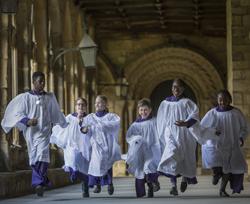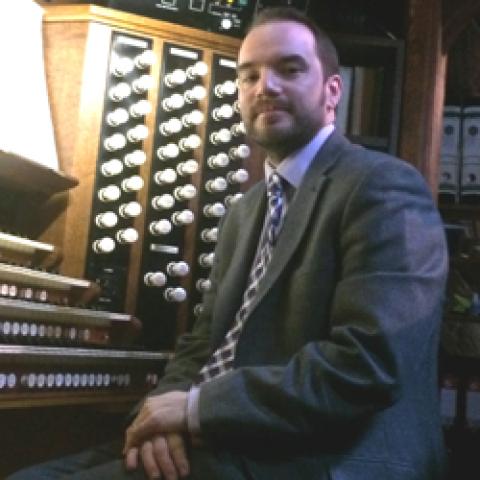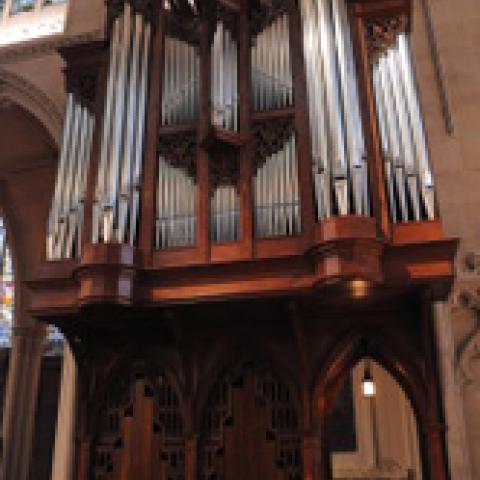Cuthbert and the Cow
Cuthbert (634–687 AD) was a monk and later a bishop in the Northumbrian Church, in the northeast of England, the area of modern Newcastle, near the Scottish border. After his death, his remains had remarkable adventures, which seemed to contribute as much to his eventual sainthood as did his activities while breathing. Eleven years after his death, his tomb was opened in preparation for his reburial, and to the amazement of those present, his corpse was miraculously preserved, inspiring the swift development of a cult honoring his memory and making him the most popular saint in England at the time.
Several centuries after his death, his admirers dug up his remains again to take him on the lam, protecting him from a Danish invasion. Suddenly and mysteriously, the cart carrying the coffin became stuck in the road. According to the legend, it wasn’t mud, and it wasn’t a mechanical breakdown, it was just stuck. Bishop Aldun, the leader of Cuthbert’s groupies, had a vision that St. Cuthbert was asking to be taken to Dunholme. Trouble was, no one knew where that was. As they pondered, a milkmaid wandered by looking for her lost cow. When she asked if anyone had seen her cow, a young woman pointed up the road, saying she had seen the cow heading toward Dunholme (now Durham). Miraculously, the cart was freed, and the roadies continued to Durham. Cuthbert was buried there and a great church was built to honor his memory. The present cathedral was built on the same site a century later, and Cuthbert was unearthed again and moved to a shrine attached to the new building. Apparently that was the end of Cuthbert’s travels, more than 400 years after his death, though after all that, I wouldn’t stand too close to his grave, beautifully preserved or not.
The episode with the cart might have been the first time on record that the men stood around wondering where they were, while a woman asked for directions. By the way, she found her cow, whose role in the legend is commemorated by a Victorian bovine statue, in a niche high on the exterior of the cathedral.
§
Durham Cathedral is an incredible place. William the Conqueror appointed William of St. Carilef as the first bishop there in 1081. Construction of the new cathedral started in 1093, and the nave was completed around 1130 (AD, not AM). It’s officially called the Cathedral Church of Christ, Blessed Mary the Virgin, and St. Cuthbert of Durham. “Durham Cathedral” works for me. While the great buildings of the High Gothic defy gravity, relying on exterior buttresses to support the weight of huge high ceilings while walls are nearly all glass and apparently structure-free, the Norman architecture of Durham Cathedral is gravity-intensive. The ancient fabric of the building is solid, and it seems as though the engineers and architects were experimenting as they went. Some arches are round while others are pointed, and clerestory windows don’t line up above those in lower stories. Buttresses between the windows are integral with the building, amounting to “thickening” of the walls rather than flying free.
Wendy and I spent one night in Durham during our recent trip to England. After dinner, we walked up to the cathedral where bellringers’ practice was going on, and the building was bathed in light. I had the sense that we were witnessing the early development of monumental ecclesiastical architecture, a prelude for our visit the next day to the High Gothic masterpiece of York Minster. The 150 or so years between the buildings at Durham and York, just seventy miles apart, brought incredible advances in construction techniques. Those builders were true innovators, and I wonder how much communication there was between builders in England and those in France at the same time. There was no Chunnel facilitating travel between the two countries, but there must have been plenty of interchange. Maybe there were international job fairs for medieval stonecutters. Come visit us at booth #1081.
Durham is home to 65,000 people and is about 270 miles from London. It’s a long way to go for a one-night visit, but besides visiting the cathedral, I was being offered a cobblers’ dream holiday. Church musicians make pilgrimages to the Chapel of King’s College in Cambridge to hear the world-famous choir and organ. I got to see that iconic Harrison & Harrison organ in the workshop during its reconstruction.
Not that Harrison,
The American organ world celebrates a British immigrant organbuilder who started his working life as a patent attorney before “catching the bug.” G. Donald Harrison was largely responsible for the development of the American Classic pipe organ—that unique style of instrument found in places like the Church of the Advent in Boston, known for sprightly Principal choruses and Baroque-inspired secondary choruses on Positiv divisions with low wind pressure. They represent a style unto themselves and helped inspire the mid-twentieth century revival of classic styles of organbuilding. Harrison was also responsible for the great organs of the Mormon Tabernacle in Salt Lake City and the Riverside Church in New York City.
I mention Mr. Harrison somewhat out of context here because we’ve just passed the 60th anniversary of his death. In June of 1956, he was working feverishly to complete the rebuilding of the Aeolian-Skinner organ at St. Thomas Church in New York City in time for the convention of the American Guild of Organists, while New York was suffering the unfortunate combination of a heat wave and strike of taxi drivers. After work on June 14, Harrison walked the eight blocks from St. Thomas to his Third Avenue apartment, stopping on the way to pick up a dose of smelling salts. After dinner, while watching Victor Borge on television with his wife, Helen, Harrison suffered a fatal heart attack.
Four days after Harrison’s death, the British organist John Scott was born in Wakefield, Yorkshire, foreshadowing Scott’s brilliant career as organist and director of music at St. Thomas Church, so sadly cut short last August by his sudden death.
That Harrison (& Harrison).
In 1861, Thomas Harrison established a pipe organ building company in Rochdale, near Manchester in the U. K., and in 1876, he moved the company to Durham. He built a number of wonderful organs, and the company really took off when his sons Arthur and Harry took over in 1896. They were exceptionally gifted organbuilders, Harry at the design table and Arthur in the voicing room. The catalogue of Harrison & Harrison organs shows dozens of instruments built in the first decades of the twentieth century. Arthur and Harry must have been especially pleased to have the hometown opportunity to rebuild the 1876 Willis organ in Durham Cathedral in 1905. Arthur Harrison died in 1936, and Harry retired in 1946, and the cows came home when control of the firm was passed on to Harry’s son, Cuthbert in 1945. Cuthbert was director of the firm until 1975 and remained Chairman of the Board until his death in 1991.
Mark Venning ran the company from 1975 until 2011, when Christopher Batchelor was appointed managing director. Dr. Batchelor was my tour guide in the busy workshop, where, among other projects, the King’s College organ was being prepared for shipment back to Cambridge.
A member of the Harrison & Harrison staff met us at the train station, dropped Wendy off at The Victoria Inn (a crazy little B&B above a six-stool pub), and took me to the workshop, a snazzy place built in 1996 to replace a 124-year-old building that had outlived its usefulness. There’s a small entry vestibule (narthex?) inside the front door that contained two items of interest. One was a four-stop dual-pitched continuo organ (which is for sale), and the other was a letter signed by Queen Elizabeth, framed with a special commemorative medal honoring the work done by Harrison & Harrison as part of the restoration of Windsor Castle following the devastating fire there in 1992.
An organ fit for a king
Reading that letter, I remembered thoughts I had while watching the wedding of Prince William and Kate Middleton on television in 2011. That was some job for the organ tuners. The Harrison & Harrison organ at Westminster Abbey was installed in 1937 and was played for the first time for the Coronation of King George VI, the father of Queen Elizabeth. We were recently reminded of King George VI, as he was the central character in the 2010 movie, The King’s Speech. Remember, he’s the one who became king when his brother King Edward VIII abdicated the throne to marry Wallis Simpson.
All of us in the business of organ building have been involved in projects that must be finished by Christmas, by Easter, or in time for the wedding of the donor’s daughter. But who else besides the people of Harrison & Harrison have been faced with such momentous events, so many times? An internationally televised royal wedding or coronation is a terrible time for a cipher!
And speaking of kings, the marvelous Harrison & Harrison organ at King’s College was built in 1934. There are famous photographs that show the organ case perched atop the central screen. Graceful towers on either side of the case seem like upraised arms, while the center of the main case ducks out of the way of the view. It looks monumental, but in fact, the case is not large enough to house the massive organ, so much of the instrument is concealed within the screen, below the level of the organ’s console.
Installing a large organ in an ancient building is charged with difficulties. Even though the chapel building is huge (those at King’s College, Duke University, and Valparaiso University are supposedly the world’s largest collegiate chapels), the original designers made no provision for placement of an organ. And if they had, they would never have conceived of our modern instruments with 32-foot pipes, heavy expression boxes, and all the other pneumatic goodies that take up so much space.
The organ at King’s College is used very heavily, and after 80 years, mechanical systems became increasingly difficult to maintain, so much of the mechanical structure of the instrument is new, including windchests, reservoirs, structure, expression boxes, and other appliances. Maintenance passage boards are mounted on hinges to swing up, providing freer egress of sound, especially allowing the organists to better hear the organ from the console. All of the new structure was standing in the shop during my visit. A large part of the project was complete before the organ was removed early in 2016.
The original pipes are being cleaned and repaired, ready for installation during the summer, with the project scheduled for completion in September. We (along with millions of others) can all look forward to hearing the renovated instrument in the broadcast of the Festival of Nine Lessons and Carols on Christmas Eve.
I found it strangely moving to see pipes in crates from particular stops I remember hearing on recordings and radio broadcasts, like the English Horn in Berlioz’s Shepherds’ Farewell. And who among us hasn’t wept to the strains of that Tuba pointing out the melody under descants in Hark, the Herald Angels Sing, or O Come, All Ye Faithful? (Special thanks to the late David Willcocks.) I also saw the famous gold-leafed façade pipes, many of which date from the original organ built in 1605, some of which had suffered terrible gravity-induced damage. A pair of cheerful metal workers showed me how they were cutting off time- and weight-ravaged toes, reinforcing the pipe feet, and soldering on new cast toes—a sort of galvanized pedicure.
A fund-lowering pitch
As Peterborough Cathedral celebrates its 900th anniversary, they’ve embarked on an ambitious campaign, raising funds for a large number of extraordinary projects. You can see the scope of Peterborough 900 on the cathedral’s website at www.peterborough-cathedral.org.uk/home/campaign-objectives.aspx. Two of the projects are directly related to music. One is a £1,000,000 Cathedral and Community Music School (when we were in the U. K. last month, £1 cost almost $1.50), and the other is lowering the pitch of the 1884 Hill Organ. The organ was originally built at “Old Philharmonic Pitch,” commonly used in the late nineteenth century. While modern concert pitch is A = 440 cycles per second, Old Philharmonic Pitch is A = 453 Hz, enough higher that singers are surprised by it, and many modern orchestral instruments can’t match it.
Changing the pitch of a large pipe organ is a complicated process. Each pipe has to be made longer (the Peterborough organ has 5,286 pipes). It’s also a tricky decision because lengthening an organ pipe changes its scale, which is the ratio of length by diameter. During my tour, I saw many pipes from the Peterborough organ, both wood and metal, with their extensions and new tuning scrolls in various stages of completion. I was impressed that big projects on two huge and famous organs were underway in the workshop at the same time. There sure were a lot of organ parts stacked about. And that wasn’t all. A new two-manual tracker-action instrument was underway as well.
When one is not enough
The morning after my tour of the Harrison & Harrison workshops, H&H operations manager Jeremy Maritz met Wendy and me “by the font” at the west end of Durham Cathedral to show us the organ. The three of us crowded into the tiny console gallery above the quire and explored the kaleidoscope of tone color revealed by the luxurious ivory drawknobs. Isn’t it rich when a Great division has both First and Second 8′ Diapasons? But wait—this organ has four! It’s the Swell division that has “only” First and Second Diapasons. And here’s a new one—in the Pedal division, Open Wood 16′ I and Open Wood 16′ II. Those two huge stops are located on opposite sides of quire, in the surrounding ambulatory—and it’s Open Wood 16′ II that’s extended to 32-foot. Heavens! And as if that’s not enough, there’s also a 16′ Diapason made of metal. Reeds, you ask? 32′ Double Ophicleide (an extension of the Solo Tuba) and 32′ Double Trombone. It’s embarrassing.
I’m grateful to Jeremy Maritz, Christopher Batchelor, and the staff of Harrison & Harrison for their hospitality and for the great education I received at their hands.
Betting on the future of the past
Here in the United States, lotteries operated by governments are a mixed bag. In Colorado, proceeds from the state lottery are largely invested in parks and recreational facilities, while in Kansas significant lottery money goes to the construction and maintenance of prisons. In Great Britain, the Heritage Lottery Fund provides funding for countless projects related to the preservation of the country’s heritage, from steam-powered tugboats to church bells, from medieval cathedrals to pipe organs. Actually, the projects are not countless—the lottery’s website claims that £6.8 billion have been awarded to support 39,000 projects since 1994.
Durham Cathedral has an ongoing project called Open Treasure that involves restoration and preservation of the building itself as well as new programs and uses for the enclosed spaces. Exhibition spaces are being developed for the display of incredible treasures owned by the cathedral, and the lottery has provided £3,850,000. Peterborough 900 has received grants totaling £2.5 million from the lottery.
Go to the website www.hlf.org.uk, type “pipe organs” into the search field, and you’ll find a list of projects that have been supported by grants from the Heritage Lottery Fund—from £44,000 for the restoration of the 1881 organ built by K. C. Reiter in the parish church of All Saints’, Roos, to £950,000 toward the restoration of the Harrison & Harrison organ at Royal Festival Hall.
During our trip, we saw signs proclaiming the support of the HLF at York Minster, Blenheim Palace, and the Ashmolean Museum in Oxford. We saw it at Westminster Abbey and at St. Martin in the Fields at Trafalgar Square.
The Heritage Lottery Fund is one of twelve specialty funds that disperse the proceeds of the National Lottery (www.national-lottery.co.uk). Other funds support arts councils, sports organizations, and the British Film Institute. As a short-term observer from the outside, it seemed pretty enlightened to me. Can you imagine our federal legislature coming up with something like that? I’d buy a ticket.




